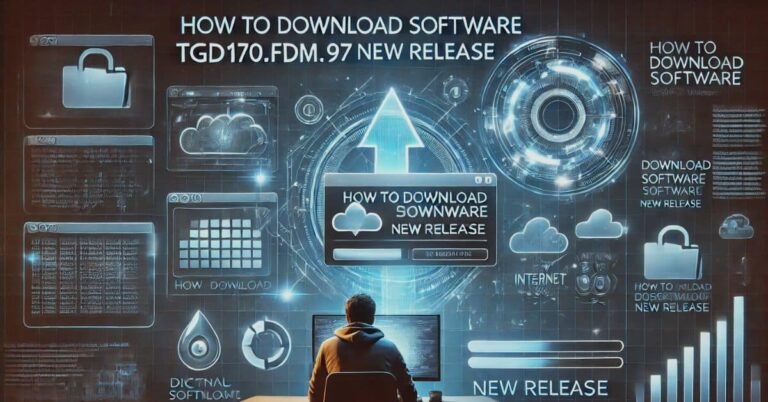Understanding Software Codes TGD170.FDM.97: A Complete Guide
Introduction
In the digital landscape, software codes play a crucial role in the smooth operation of various applications, systems, and processes. One such essential software code is TGD170.FDM.97. This guide will provide a deep dive into the significance, functionality, and applications of software codes TGD170.FDM.97, helping professionals and developers understand its importance. Whether you’re a software engineer, an IT specialist, or a tech enthusiast, this guide will help you navigate through this software code with ease.
What is Software Codes TGD170.FDM.97?
Software codes like TGD170.FDM.97 are critical for specific operational or functional aspects of a software system. This code is typically associated with particular programming frameworks, databases, or system integrations. Understanding software codes TGD170.FDM.97 can help in troubleshooting, optimizing, and enhancing software performance.
Importance of Software Codes in Development
Software codes act as the backbone of any software system. Here are some key reasons why TGD170.FDM.97 is important:
- Enhances Functionality – The implementation of TGD170.FDM.97 ensures that specific functionalities operate as expected.
- Optimizes Performance – Proper usage can lead to performance improvements.
- Ensures Compatibility – This code may facilitate compatibility between different software modules.
- Supports Security Measures – Certain software codes help in strengthening security protocols.
- Facilitates Automation – Enables automation of repetitive tasks, increasing efficiency.
- Improves Debugging and Maintenance – Helps identify errors and streamline software maintenance.
Understanding the Components of Software Codes TGD170.FDM.97
To gain a complete understanding, it is essential to break down the different components of TGD170.FDM.97:
1. Syntax and Structure
Understanding the syntax of software codes TGD170.FDM.97 is crucial for developers. It follows a structured format that aligns with the programming environment in which it is used. Developers must adhere to specific rules and logic to ensure seamless execution.
2. Application and Use Cases
The TGD170.FDM.97 code is used across various industries and applications, including:
- Enterprise Software Solutions
- Data Management Systems
- Software Integration Platforms
- Custom Application Development
- AI and Machine Learning Models
- Cloud Computing Services
- IoT (Internet of Things) Devices
3. Implementation Process
Implementing software codes TGD170.FDM.97 involves several steps:
- Analyzing Requirements – Understanding where and how the code will be used.
- Writing the Code – Following best practices in coding to ensure efficiency.
- Testing and Debugging – Running tests to identify and fix potential issues.
- Deploying and Monitoring – Ensuring smooth deployment and ongoing maintenance.
4. Security Aspects of Software Codes TGD170.FDM.97
Security is a major concern in software development. Here are some security measures to consider when working with TGD170.FDM.97:
- Encrypting Sensitive Data
- Using Secure Authentication Protocols
- Regular Security Audits and Updates
- Implementing Role-Based Access Control (RBAC)
Best Practices for Using Software Codes TGD170.FDM.97
To maximize the benefits of software codes TGD170.FDM.97, follow these best practices:
- Maintain Clean Code – Use proper indentation, comments, and naming conventions.
- Regularly Update – Keep the code updated with the latest patches and versions.
- Implement Security Protocols – Ensure safe implementation to prevent vulnerabilities.
- Perform Extensive Testing – Validate the code before deploying it in a production environment.
- Optimize for Performance – Reduce redundant code and improve execution speed.
- Document the Code – Maintain comprehensive documentation for easy reference and future updates.
Common Issues and Solutions
1. Code Compatibility Issues
- Problem: The code does not integrate well with existing software.
- Solution: Check for version updates and compatibility requirements.
2. Performance Lag
- Problem: Slow execution due to inefficient implementation.
- Solution: Optimize the code structure and minimize redundant processes.
3. Security Vulnerabilities
- Problem: Unauthorized access or data breaches.
- Solution: Implement robust encryption and authentication measures.
4. Incorrect Syntax Implementation
- Problem: Errors due to improper syntax.
- Solution: Use debugging tools and code validation techniques.
5. Scalability Challenges
- Problem: The software code does not support scaling.
- Solution: Optimize the code for modularity and scalability.
How Software Codes TGD170.FDM.97 Enhances Software Performance
1. Speed Optimization
Efficient coding practices help in improving execution speed, reducing lags, and enhancing user experience.
2. Reducing Redundancy
Well-structured code eliminates unnecessary functions and repetitive tasks, resulting in better efficiency.
3. Seamless Integration
Ensures smooth integration with other software, APIs, and databases.
4. Better Error Handling
Helps in identifying and fixing errors quickly, minimizing downtime.
Future Trends in Software Coding and TGD170.FDM.97
1. AI-Driven Code Optimization
Artificial Intelligence (AI) is playing a significant role in automating code optimization, making software codes like TGD170.FDM.97 more efficient.
2. Cloud-Based Development
With the rise of cloud computing, TGD170.FDM.97 is expected to be increasingly used in cloud-based applications.
3. Enhanced Security Measures
Cybersecurity threats are evolving, and software codes will incorporate more advanced encryption and authentication protocols.
4. Automation and Low-Code Development
Automation tools and low-code development frameworks will make the use of TGD170.FDM.97 more accessible to non-developers.
READ MORE: How to Download Software tgd170.fdm.97 New Release – Step-by-Step Guide
FAQs About Software Codes TGD170.FDM.97
What is the primary function of software codes TGD170.FDM.97?
TGD170.FDM.97 is used for optimizing specific software operations, ensuring compatibility, and enhancing functionality in various applications.
How often should software codes TGD170.FDM.97 be updated?
Regular updates are recommended to align with system improvements, security patches, and performance enhancements.
Can software codes TGD170.FDM.97 be modified?
Modifications depend on the software framework and its flexibility. However, any changes should be well-documented and tested.
What are the common errors when implementing software codes TGD170.FDM.97?
Common errors include incorrect syntax, version incompatibility, and security loopholes. Debugging and proper documentation can help mitigate these issues.
How can I troubleshoot issues related to software codes TGD170.FDM.97?
Using debugging tools, reviewing logs, and testing different configurations can help resolve most problems associated with TGD170.FDM.97.
Conclusion
Understanding software codes TGD170.FDM.97 is essential for developers and IT professionals aiming to optimize software functionality. By implementing best practices, troubleshooting effectively, and staying updated, you can ensure smooth integration and operation of this software code. Whether you’re using it for system compatibility, performance enhancement, or security measures, TGD170.FDM.97 remains a valuable asset in the software development landscape.





